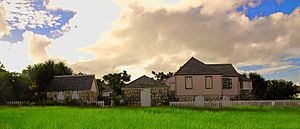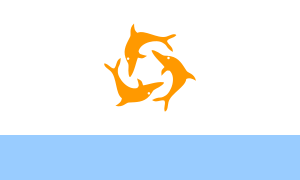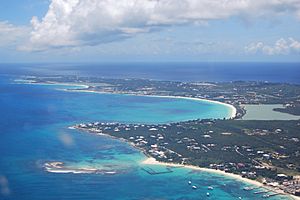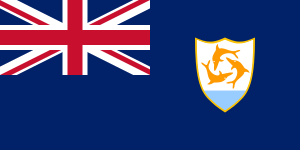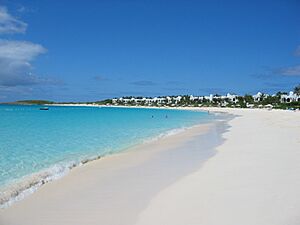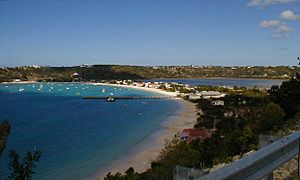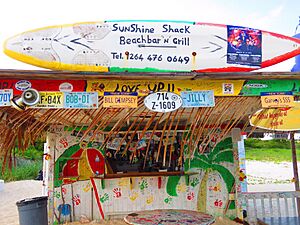Anguilla facts for kids
Quick facts for kids
Anguilla
|
|||
|---|---|---|---|
|
|||
| Motto(s):
"Unity, Strength and Endurance"
|
|||
| Anthem: "God Save the King" | |||
| National song: "God Bless Anguilla" | |||

Location of Anguilla (red)
|
|||
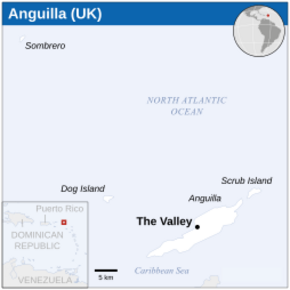 |
|||
| Sovereign state | |||
| English control | 1667 | ||
| Federation with Saint Kitts and Nevis | 1871 | ||
| Secession and independence | 12 July 1967 | ||
| British control restored | 18 March 1969 | ||
| Capital and largest city
|
The Valley 18°13′15″N 63°03′06″W / 18.22083°N 63.05167°W |
||
| Official languages | English | ||
| Ethnic groups
(2011)
|
|||
| Demonym(s) | Anguillan | ||
| Leaders | |||
|
• Monarch
|
Charles III | ||
|
• Governor
|
Julia Crouch | ||
|
• Deputy Governor
|
Perin A. Bradley | ||
|
• Premier
|
Cora Richardson-Hodge | ||
| Legislature | House of Assembly | ||
| Area | |||
|
• Total
|
91 km2 (35 sq mi) | ||
|
• Water (%)
|
negligible | ||
| Highest elevation | 73 m (240 ft) | ||
| Population | |||
|
• 2018 estimate
|
14,731 (not ranked) | ||
|
• 2011 census
|
13,452 | ||
|
• Density
|
132/km2 (341.9/sq mi) (not ranked) | ||
| GDP (PPP) | 2014 estimate | ||
|
• Total
|
$311 million | ||
|
• Per capita
|
$29,493 | ||
| GDP (nominal) | 2020 estimate | ||
|
• Total
|
US$307,000,000 | ||
| Currency | Eastern Caribbean dollar (XCD) | ||
| Time zone | UTC−04:00 (AST) | ||
| Date format | dd/mm/yyyy | ||
| Driving side | left | ||
| Calling code | +1-264 | ||
| UK postcode |
AI-2640
|
||
| ISO 3166 code | AI | ||
| Internet TLD | .ai | ||
| Website | gov.ai | ||
Anguilla (pronounced ang-GWIL-uh) is a British Overseas Territory located in the Caribbean. It is one of the most northern islands in the Leeward Islands group, part of the Lesser Antilles. Anguilla lies east of Puerto Rico and the Virgin Islands, and directly north of Saint Martin.
The territory includes the main island of Anguilla, which is about 26 kilometers (16 miles) long and 5 kilometers (3 miles) wide. It also has several smaller islands and cays (small, low islands) that no one lives on permanently. The capital city is The Valley. The total land area is 91 square kilometers (35 square miles), and about 15,753 people live there (as of 2023).
Contents
What's in a Name?
The first people to live on the island, the Arawaks, called it Malliouhana.
Later, Europeans named it Anguilla. This name comes from the Italian word anguilla, which means "eel." It was likely named this because of the island's long, thin shape. Some people believe Christopher Columbus gave the island this name in 1493.
Anguilla's History
Anguilla was first settled by Native American groups who traveled from South America. The oldest items found from these early settlers date back to about 1300 BC. Remains of their villages have been found from around AD 600.
There are also two places on Anguilla with petroglyphs, which are ancient rock carvings. One of these, Big Spring, has over 100 carvings, many of which look like faces.
It's not clear exactly when Europeans first saw Anguilla. Some say Columbus saw it in 1493. Others say the first European explorer was a French nobleman named René Goulaine de Laudonnière in 1564. The Dutch West India Company built a fort here in 1631, but the Spanish destroyed it in 1633.
English settlers from Saint Kitts first came to Anguilla in 1650. They mainly grew tobacco and some cotton. The French took over the island for a short time in 1666 but gave it back to the English in 1667. The French tried to capture the island again in 1688, 1745, and 1798, causing a lot of damage, but they never succeeded.
Early European settlers brought enslaved Africans to the island. By 1683, there were at least 100 enslaved people in Anguilla, many from Central and West Africa. They were forced to work on sugar plantations, which became the main crop. Over time, the enslaved Africans and their descendants became the largest group on the island. The trade of enslaved people was stopped in the British Empire in 1807, and slavery was completely outlawed in 1834.
For a long time, Anguilla was managed by the British through Antigua. In 1825, it was placed under the control of nearby Saint Kitts. In 1882, Anguilla was joined with St Kitts and Nevis, even though many Anguillans didn't want this. Hard times, like droughts and the Great Depression in the 1930s, caused many Anguillans to leave the island to find better opportunities.
In 1952, all adults in Anguilla gained the right to vote. After being part of the West Indies Federation for a few years (1958–1962), Anguilla became part of the state of Saint Kitts-Nevis-Anguilla in 1967. This state had its own government, but many Anguillans were unhappy with being controlled by St Kitts.
On May 30, 1967, Anguillans forced the St Kitts police off the island. They then declared their separation from St Kitts after a public vote. This event, led by people like Atlin Harrigan and Ronald Webster, is known as the Anguillan Revolution. Their main goal was to separate from Saint Kitts and Nevis and become a British colony again.
When talks to solve the problem failed, another vote was held in 1969. Anguillans again voted to separate from St Kitts, and the Republic of Anguilla was declared, with Ronald Webster as president. To restore order, 300 British troops were sent to the island in March 1969. British control was re-established. In 1980, Anguilla was finally allowed to officially separate from Saint Kitts and Nevis and become a separate British Crown colony (which is now a British overseas territory). Since then, Anguilla has been peaceful and has seen a lot of growth in tourism and financial services.
Anguilla's Land and Nature
Anguilla is a flat, low-lying island made of coral and limestone in the Caribbean Sea. It is about 26 kilometers (16 miles) long and 6 kilometers (3.5 miles) wide. It is located east of Puerto Rico and the Virgin Islands, and just north of Saint Martin, separated by the Anguilla Channel.
The soil on the island is generally thin and not very rich. It mostly supports scrub, tropical plants, and some forest. The land is mostly flat, with the highest point near The Valley. Crocus Hill, Anguilla's highest peak, is 73 meters (240 feet) tall and is in the western part of the town.
Anguilla is famous for its important coral reefs and beautiful beaches. Besides the main island, the territory includes several smaller islands and cays. Most of these are tiny and no one lives on them:
- Anguillita
- Blowing Rock
- Dog Island
- Little Scrub Island
- Prickly Pear Cays
- Scrub Island
- Seal Island
- Sombrero, also called Hat Island
- Sandy Island
- Scilly Cay
About 61% of Anguilla's land is covered by forest, which is about 5,500 hectares (in 2020).
How Anguilla Was Formed
Anguilla and the surrounding area were formed by volcanoes. Rocks from volcanic eruptions that happened millions of years ago can be found on the island. Later, much of the island was underwater, which led to the formation of the limestone that covers most of Anguilla today. Over time, the land was lifted up, creating the island we see.
Weather in Anguilla
Temperature
The island has a tropical climate, meaning it's warm all year. Winds from the northeast, called trade winds, help keep it from getting too hot and also keep it relatively dry. The average yearly temperature is about 27°C (80°F). The hottest time is from July to October, and the coolest is from December to February.
Rain and Storms
Anguilla gets about 890 millimeters (35 inches) of rain each year, but this can change a lot from season to season and year to year. The island can experience sudden tropical storms and hurricanes, especially from July to November. Anguilla was hit by Hurricane Luis in 1995, Hurricane Lenny in 1999 (which caused severe flooding), and Hurricane Irma in 2017. Hurricane Irma was the strongest hurricane to hit the island and caused a lot of damage.
How Anguilla is Governed
Anguilla is a British overseas territory, which means it belongs to the United Kingdom but has its own government for internal matters. It has a parliamentary system where the Premier is the head of the government. The British government appoints a Governor to represent the King.
The United Nations Committee on Decolonization lists Anguilla as a non-self-governing territory. Anguilla's rules for government are set out in the Anguilla Constitutional Order from 1982. The government makes decisions, and the House of Assembly makes laws. The courts are separate from the government and law-making bodies.
Protecting Anguilla
Since Anguilla is a British overseas territory, the UK is responsible for its defense. There are no permanent military bases or armed forces on the island. However, the Royal Navy has a patrol ship, HMS Medway, in the Caribbean to help protect the area.
Anguilla also has a small local marine police force with about 32 officers and a fast patrol boat. The Royal Anguilla Police Force is in charge of policing on the island.
People of Anguilla
Who Lives There?
Most people in Anguilla (about 90%) are of West African descent. They are mostly descendants of enslaved people brought from Africa. Smaller groups include white people (about 3.7%) and people of mixed race (about 4.6%). About 72% of the population are Anguillan, while 28% are from other countries, including the United States, United Kingdom, St Kitts & Nevis, the Dominican Republic, and Jamaica.
In 2006 and 2007, many workers from China, India, and Mexico came to Anguilla. They were needed for large tourism projects because there weren't enough local workers.
Religions in Anguilla
Christianity is the main religion in Anguilla. The Wesleyan (Methodist) church built churches and schools starting in 1817.
According to a 2001 census, about 29% of people are Anglican, and 23.9% are Methodist. Other churches on the island include Seventh-day Adventist, Baptist, and Roman Catholic. There is also a small group of Jehovah's Witnesses. The number of followers of the Church of God and Pentecostals grew a lot between 1992 and 2001. There are at least 15 churches on the island.
Anguilla is also important to followers of the Rastafarian religion because it is the birthplace of Robert Athlyi Rogers, who wrote the Holy Piby. This book greatly influenced Rastafarian beliefs. More recently, a Muslim cultural center has opened on the island.
| Religion | 1992 | 2001 | 2011 |
|---|---|---|---|
| Anglican | 40.4 | 29.0 | 22.7 |
| Methodist | 33.2 | 23.9 | 19.4 |
| Pentecostal | – | 7.7 | 10.5 |
| Seventh-day Adventist | 7.0 | 7.6 | 8.3 |
| Baptist | 4.7 | 7.3 | 7.1 |
| Catholic | 3.2 | 5.7 | 6.8 |
| Church of God | – | 7.6 | 4.9 |
| None | – | 4.0 | 4.5 |
Languages Spoken
Most people in Anguilla speak a type of standard English that is influenced by British English. Other languages like Spanish and Chinese are also spoken by immigrant communities.
However, the most common language besides standard English is the island's own English-lexifier Creole language. Locals call it "dialect," Anguilla Talk, or "Anguillian." This language has its roots in early forms of English and West African languages. It is similar to the dialects spoken on other English-speaking islands in the Eastern Caribbean.
Experts believe that "Anguillian" developed as the main language for most people over time, especially after slavery ended and locals began to feel a strong connection to Anguillan society.
Learning in Anguilla
Anguilla has six government primary schools and one government secondary school, called Albena Lake Hodge Comprehensive School. There are also two private schools. The main library is the Edison L. Hughes Education & Library Complex.
A branch of the Saint James School of Medicine, a private medical school, opened in Anguilla in 2011. There is also a University of the West Indies Open campus site on the island, offering higher education.
Anguilla's Culture
Anguilla's cultural story began with the native Taino, Arawak, and Carib people. Their ancient tools and items found around the island tell us about their lives before Europeans arrived.
Anguillan culture has also been shaped by people moving to the island. Many European families have settled there, influencing the island's customs. You can see this influence in restaurants like Dolce Vita and Roy's Bayside Grill in Sandy Ground.
Like other Caribbean islands, Anguilla's location means its culture is closely tied to the ocean. The island has a lot of sea life, which is a big part of daily life. Seafood is used in local dishes, creates opportunities for ecotourism, and inspires celebrations like Lobster Fest and exciting boat races.
Holidays are very important in Anguilla. The most significant holidays have both historical and cultural meaning. These include the anniversary of emancipation (when slavery ended), celebrated as the Summer Festival or Carnival, which features sailboat races and Lobster Fest. British holidays, like the King's Birthday, are also celebrated.
Music is a very important part of Anguillan culture. Different types of music are played at these celebrations, showing the long history of musical talent on the island.
The Anguilla National Trust (ANT) was created in 1989 to help protect the island's heritage, including its cultural history. The Heritage Collection Museum used to display Anguilla's history and artifacts, but in 2024, its collection was moved to the Anguilla National Museum.
What Anguillans Eat
Anguillan food is a mix of native Caribbean, West African, Spanish, French, and English cooking styles. Seafood is very common, including prawns, shrimp, crab, spiny lobster, conch, mahi-mahi, red snapper, marlin, and grouper. Salt cod is a basic food, eaten alone or in stews and soups.
Because the island is small, there isn't much space for raising animals. So, people eat poultry (like chicken), pork, goat, and mutton, along with imported beef. Goat is the most common meat and is used in many dishes. The official national food of Anguilla is pigeon peas and rice.
A lot of the island's food is imported because there isn't much good land for farming. The soil is often sandy and not very fertile. Anguilla does grow some tomatoes, peppers, limes, onions, garlic, squash, pigeon peas, and callaloo. Common starchy foods include imported rice, and locally grown foods like yams, sweet potatoes, and breadfruit.
Anguillan Stories and Poems
The Anguilla National Trust has programs that support Anguillan writers and help preserve the island's history. In 2015, a new collection of poems called Where I See The Sun – Contemporary Poetry in Anguilla was published. It featured works by many Anguillan poets.
Music of Anguilla
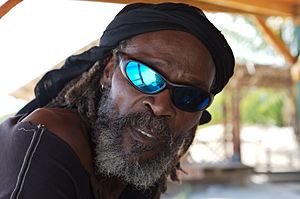
Many Caribbean music styles are popular on the island, such as soca and calypso. However, reggae music is especially important in Anguillan society. Anguilla has produced many talented reggae artists and groups.
Reggae is the most popular music style in Anguilla. Some of the most successful reggae artists from Anguilla are from the Banks family. Bankie Banx and his son Omari Banks have had many popular songs played worldwide. They often perform live on the island.
The band British Dependency has also become popular in the 21st century. This band, which started in Anguilla, features the island's first female bass player. They have gained attention from American audiences by performing with famous bands like The Wailers.
One of the many music events in Anguilla is Moonsplash. Moonsplash is an annual reggae music festival that has been held in Anguilla for 33 years in a row. It is the oldest independent music event in the Caribbean and, along with Carnival, it is the largest festival each year.
While not many soca and calypso artists from Anguilla have become extremely famous, these music styles are still widely enjoyed across the island.
Sports in Anguilla
Boat racing is a very important part of Anguillan culture and is the national sport. There are regular sailing regattas (boat races) on national holidays, like Carnival. These races feature boats built and designed locally, which have names and sponsors.
Like in many other former British colonies, cricket is also a popular sport. Omari Banks from Anguilla played for the West Indies Cricket Team. Cardigan Connor played first-class cricket for Hampshire in England and was the team manager for Anguilla's Commonwealth Games team in 2002. Other notable players include Chesney Hughes, who played for Derbyshire County Cricket Club in England.
Rugby union is played in Anguilla by the Anguilla Eels RFC, which started in 2006. The Eels have done well in tournaments, even winning the St. Martin tournament in 2010.
Anguilla is the birthplace of sprinter Zharnel Hughes, who has represented Great Britain since 2015 and England at the 2018 Commonwealth Games. He won the 100 meters at the 2018 European Athletics Championships and gold medals in the 4 x 100 meters relay at the same championships and the 2018 Commonwealth Games. He also won a silver medal in the 4 x 100 meters relay for Great Britain at the 2020 Olympic Games. In 2023, he set a new British record for the 100m sprint, finishing in 9.83 seconds.
Shara Proctor, a British Long Jump Silver Medalist at the World Championships, first represented Anguilla. She won several medals in the NACAC games under the Anguillan Flag before representing Great Britain and England from 2010.
Keith Connor, a triple jumper, is also from Anguilla. He represented Great Britain and England and won several international titles, including Commonwealth and European Games gold medals and an Olympic bronze medal. Connor later became the Head Coach of Australia Athletics.
Anguilla's Wildlife
Anguilla is home to Cuban tree frogs (Osteopilus septentrionalis). The red-footed tortoise (Chelonoidis carbonaria), which originally came from South America, can also be found here. Hurricanes in the mid-1990s helped green iguanas (Iguana iguana) spread to Anguilla by carrying them across the water. All three of these animals were introduced to the island.
Five types of bats are known to live in Anguilla: the threatened insular single leaf bat (Monophyllus plethodon), the Antillean fruit-eating bat (Brachyphylla cavernarum), the Jamaican fruit bat (Artibeus jamaicensis), the Mexican funnel-eared bat (Natalus stramineus), and the velvety free-tailed bat (Molossus molossus).
Anguilla's Economy
Anguilla's soil is thin and dry, so it's not very good for farming. The island also has few natural resources on land. Its main ways of making money are tourism, setting up and managing offshore companies, offshore banking, captive insurance (a type of insurance company), and fishing.
Anguilla's money is the East Caribbean dollar, but the US dollar is also widely accepted. The exchange rate is fixed: US$1 equals EC$2.70.
The economy, especially tourism, faced challenges after Hurricane Luis in 1995 and Hurricane Lenny in 2000. Before the worldwide financial crisis in 2008, Anguilla's economy was growing quickly, mainly because of tourism. The tourism industry got a big boost when it hosted the World Travel Awards in December 2014. Anguilla was named the World's Leading Luxury Island Destination.
However, the economy faced its biggest challenge in late 2017 due to Hurricane Irma, the most powerful hurricane to hit the island. It caused about $320 million in damage to buildings and roads. Repairs were made in 2018 and 2019, and the economy started to recover. But then, the COVID-19 pandemic in 2020 and 2021 caused another setback.
Anguilla's financial system includes seven banks, two money transfer businesses, and many companies that manage offshore businesses, insurance, and investments.
Anguilla has become a popular place for businesses because it has no taxes on capital gains, estates, profits, sales, or corporations. In 2011, to help with its budget, Anguilla introduced a 3% "Interim Stabilisation Levy," which was its first type of income tax. Anguilla also has a 0.75% property tax.
Anguilla wants to get 15% of its energy from solar power. This will help it rely less on expensive imported diesel fuel. The Climate & Development Knowledge Network is helping the government change its laws to allow more renewable energy. Anguilla is quite advanced in its plans for sustainable energy compared to many other small islands.
Recently, Anguilla has been making a lot of money from its internet domain name, .ai. Because of the growing interest in artificial intelligence, many companies want websites ending in .ai. In 2022, the number of .ai domain name registrations doubled. Experts predict that Anguilla could earn as much as $30 million in domain-registration fees in 2023.
Getting Around Anguilla
By Air
Anguilla is served by Clayton J. Lloyd International Airport (formerly Wallblake Airport). The main runway is 1,665 meters (5,462 feet) long and can handle medium-sized planes. Local airlines offer flights to other Caribbean islands.
In December 2021, Anguilla started its first regular international commercial jet service to the mainland U.S. American Eagle, flying for American Airlines, began nonstop flights from Miami to Anguilla. This was a big moment for Anguilla's airport, which is also trying to attract other international airlines.
Other airlines like Tradewind Aviation and Cape Air also offer scheduled flights to San Juan, Puerto Rico. The airport can handle large narrow-body jets like the Boeing 737 and Airbus A320, and it has a growing number of private jet flights with a new private jet terminal being built.
By Road
Besides taxis, there is no public transportation on the island. Cars drive on the left side of the road, and most roads are not paved. There is no train system.
By Boat
There are regular ferries from Saint Martin to Anguilla. The trip from Marigot, St. Martin, to Blowing Point, Anguilla, takes about 20 minutes.
There is also a special boat service that offers trips from Blowing Point, Anguilla, to Princess Juliana Airport in St. Martin.
Images for kids
-
Map showing the location of Anguilla relative to Sint Maarten/Saint Martin and other islands to its south
See Also
 In Spanish: Anguila (dependencia) para niños
In Spanish: Anguila (dependencia) para niños




